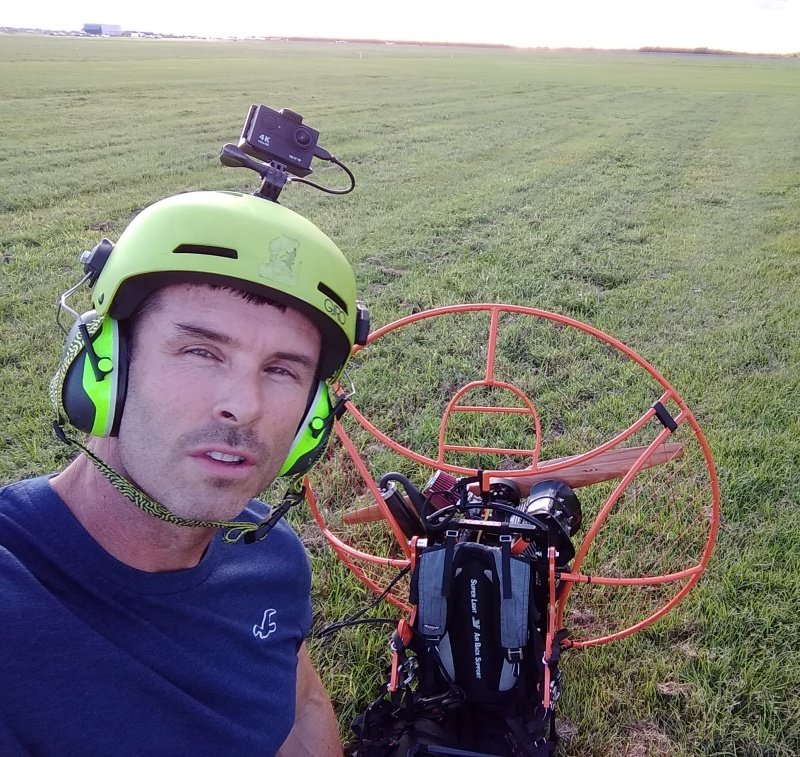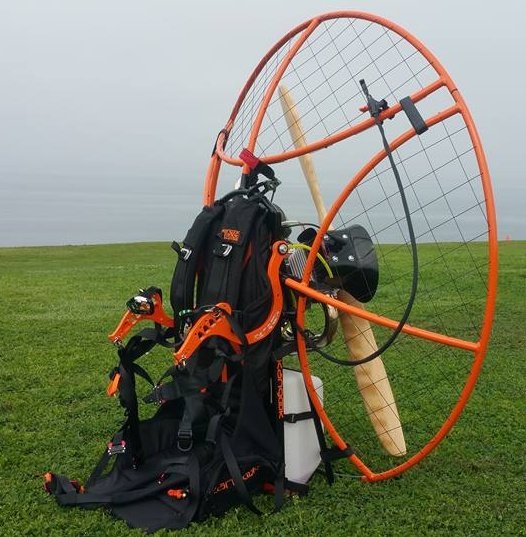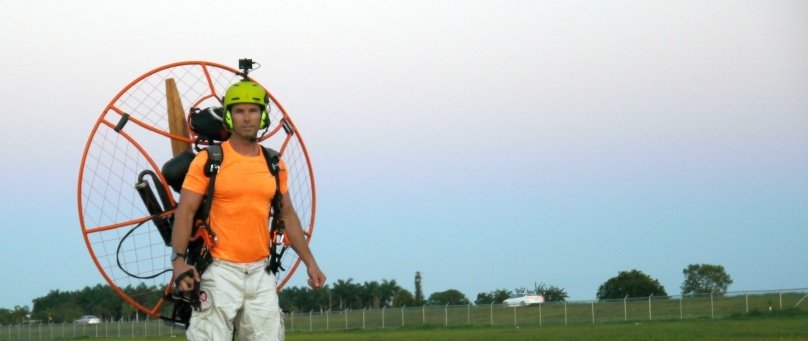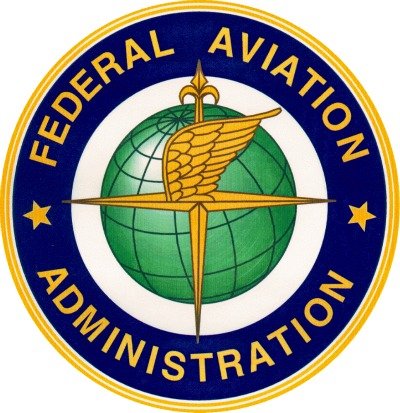What is Backpack Aircraft?
Who am I?
 Hi I’m Michael.
Hi I’m Michael.
My feet left the ground and I flew like a bird for the first time in October of 2016 in a way few on the face of the planet have ever done.
I think the paramotor is one of the most amazing flying machines ever invented, a highly capable aircraft you can carry around in your car.
This sport has definitely been a challenge and I’ve learned a lot since that first day and it’s because I enjoy discovering all I can about this paramotoring that this site exists.
This site is just a hobby I work on in my spare time so please excuse all the loose ends hanging around.
What is a powered paraglider?
A powered paraglider is type of ultralight aircraft.

It is a combination of two main components, a paraglider or “wing” that provides lift and a propulsion unit called a paramotor the pilot wears on his or her back that provides enough thrust for the aircraft to take off and fly.
So basically…
A powered paraglider is a combination of a paraglider wing and a motorized paramotor unit.
The powered paraglider “wing”
The most important part of a powered paraglider is the paraglider itself, usually referred to as the “wing” or “glider.” The wing is what makes flight possible, not the paramotor. The wing determines most of the flight characteristics like speed, handling and so on. You don’t need a paramotor to fly with a paraglider, just something tall to jump off of, like a mountain.

Paramotor Components
The propulsion unit of a powered paraglider is called a paramotor.
There are many manufacturers and different styles of paramotors all of which consist of a circular cage, an engine, fuel tank and a seating harness that retracts on take off and landings. Everything is connected to the frame of the paramotor.
In the paramotor image to the right you can see the seating harness and the round cage with the netting. This prevents body parts and other objects from coming into contact with the propeller.
The Paramotor Engine
Most powered paragliders are propelled with small 2-stroke engines and while electric motors are used, presently they are fairly rare.
 2-stroke internal combustion engines are favorable due to their impressive power-to-weight ratio for example the engine shown weighs less than 30 pounds and produces nearly 30hp! 4-stroke paramotor engines are available however the heavier weight prevents their popularity.
2-stroke internal combustion engines are favorable due to their impressive power-to-weight ratio for example the engine shown weighs less than 30 pounds and produces nearly 30hp! 4-stroke paramotor engines are available however the heavier weight prevents their popularity.
While there are many paramotor frame and cage manufacturers there are just a handful of companies that make engines.
The engine to the left is the very popular Vittorazi Moster 185.
Here I am wearing the paramotor like a backpack.
The unit weighs about 75 pounds with fuel but once you inflate the wing and start moving forward the weight is lifted by the paraglider and you run off into the sky to fly like a bird.

What is a paramotor?
It consists of a frame that combines the motor, propeller, harness (with integrated seat) and cage. It provides two attachment points for the risers of a paraglider wing that allows for powered flight.
 The term was first used by Englishman Mike Byrne in 1980[1] and popularized in France around 1986 when La Mouette began adapting power to the then-new paraglider wings.
The term was first used by Englishman Mike Byrne in 1980[1] and popularized in France around 1986 when La Mouette began adapting power to the then-new paraglider wings.
Pilots who fly these engage in paramotoring, also known as powered paragliding.
The engines used are almost exclusively small two-stroke internal combustion types, between 80cc and 350cc, that burn mixed gasoline and oil. These engines are favored for their high output power and light weight and use approximately 3.7 litres (1 US Gal.) of fuel per hour depending on paraglider efficiency, weight of motor plus pilot and conditions. At least one manufacturer is producing a 4-stroke model. Electrically powered units are on the horizon. Csaba Lemak created the first electric PPG, flying it first on June 13, 2006.[2][3] Flight duration for electrics is considerably shorter. Wankel rotary engined paramotors are also available, but rare.
The pilot controls thrust via a hand-held throttle and steers using the paraglider’s brake toggles similar to sport parachutists. Paramotor wings have evolved specifically for use with power, as compared with free flight ‘paraglider’ wings. Such wings are typically designed for a higher speed, and may incorporate a “reflex” profile to aid stability in pitch, an idea taken from hang gliders of the 1980s. The Parabatix Sky Racers is an air racing event using paramotors to race round pylons in front of spectators.[4] – From Wikipedia, the free encyclopedia
Do you need a license to fly one?
No.
 One of the attractive aspects of a PPG is that the sport has little regulation. The rules that apply to this sport are found HERE.
One of the attractive aspects of a PPG is that the sport has little regulation. The rules that apply to this sport are found HERE.
- You don’t need a license
- Age is not a factor, kids as young as 10 fly paramotors as well as seniors
- You don’t need to register or license the machine or buy insurance for it
- While PPG associations do exist, there is no requirement that you join one
- You aren’t even required to have training
You could order your flying machine online, have it delivered, strap it on your back and attempt to fly it and as long as you didn’t violate airspace rules would be perfectly legal if you did manage to get it off the ground.
Amazingly people do do this and these are the ones that usually end up hurting or killing themselves.
There is great freedom in our sport and the fact that we are pretty much allowed self governance in a world increasingly tangled with rules, regulations and red tape, is a beautiful thing.
As always there are people who abuse the freedoms that result in making the whole community look bad.
Don’t be one of THOSE people.
If you are going to drop 10K on a flying machine, it’s just good sense to invest a little more on proper training so you don’t hurt yourself or someone else.
If you want to get connected…
More links from USPPA…
Preamble to FAR Part 103 – Insight into the FAA’s reasoning for regulating ultralights
FAR Part 103 – The rules that govern ultralights in the United States
FAA Advisory Circular 103-7 – Provides guidance to ultralight operators in the United States
Applicable FAR Part 91 Regulations – Other regulations applicable to ultralights
Sport Pilots – Do powered paragliders fall under sport pilot? What about the tandem exemption? Here are some answers to these questions along with interpretation of rules that are being defined.
What law(s) govern this sport?
Is it safe?
Powered paragliding is probably the safest form of recreational aviation ever devised.
Get good instruction, pay close attention during training and respect the propeller to minimize most of the risk. Like any recreation with humans in motion, there is risk. Training and the first few hours of flight are the most critical. We estimate the overall risk is less than motorcycle riding or free flying (paragliding with no motor) or flying small airplanes but more than driving a car.
Of the minimal risk, most comes from pilot error, not equipment malfunction. A conscientious pilot with the right attitude and good instruction can make this sport incredibly safe.
What about the weather?
This question answered by Jeff Goin at the FootFlyer
For more on weather go to the PPG weather station page.
How much is it?
How do I get trained?
How high can you fly?
Watch this video for a more thorough answer…


